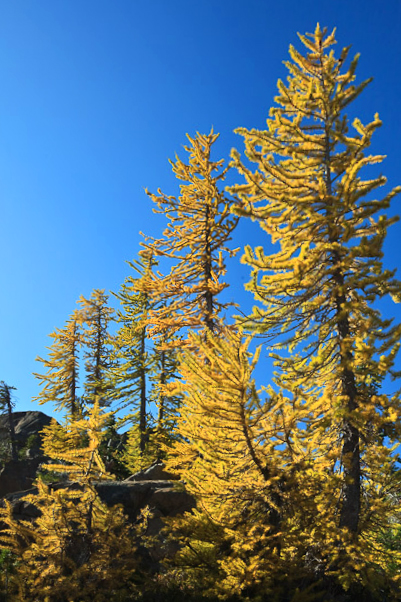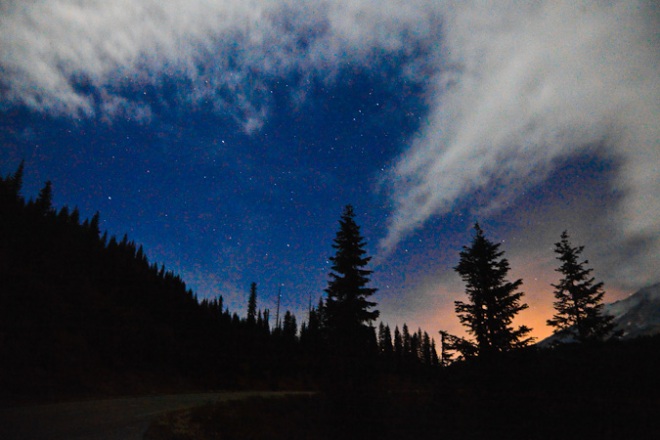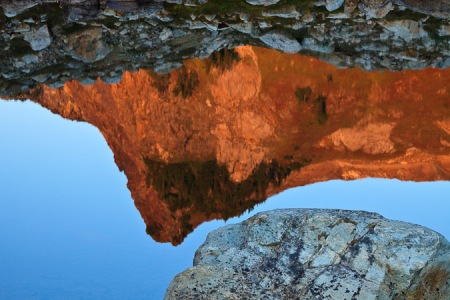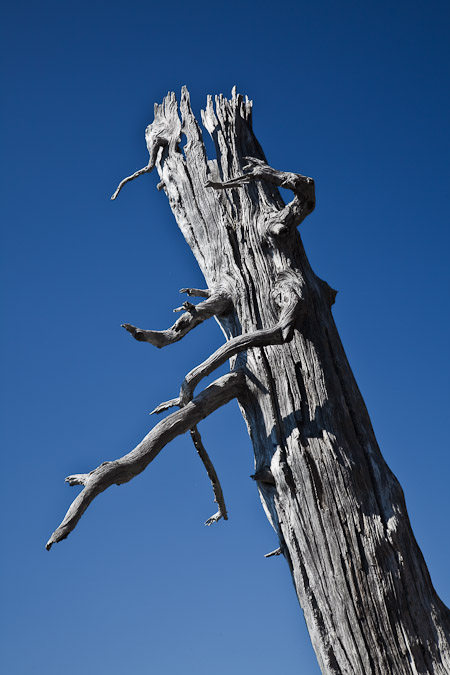.
.
Alpine Larches in Headlight Basinss
.
.
Vermont has its fiery autumn Sugar Maples that can take your breath away with a sudden shot of intensity, and walking through a Colorado Trembling Aspen forest at the shining peak of autumn is transcendent. Washington’s Cascade Mountains are cloaked in deep shades of green most of the year, but in late autumn, there is a spectacle that rivals the wondrous feeling of autumn in more easterly parts of America.
.
At timberline, in the rugged and ragged jumble of rocks and scree slopes that mark the ridges and upper basins of the Cascades, Alpine Larches gather in their favorite haunts. There, reaching like candle flames toward the deep blue sky, they briefly blaze brilliant gold, before being extinguished by frigid nights and heavy snows.
.

Needles with the color of Burnished Goldss
..
..
Hikers here consider it an autumn ritual to trudge ever upward along a steep trail to get into larch country. There may be a place or two in Washington where people can drive up to see a few Alpine Larches, but the best displays are in the wildest country.
.
 The feathery needles of Alpine Larch turn golden for a brief autumn moment..
The feathery needles of Alpine Larch turn golden for a brief autumn moment..
.
.
Karen and I looked at the forthcoming weather, and decided that October 11 looked great, with clear blue skies and on-line reports that the Alpine Larches were reaching perfection. The downside was that an arctic air mass was the reason for the beautiful October skies, so we expected cold. Really cold. As in, too cold to backpack all the necessary warm clothing and gear plus all my camera equipment. So we decided to car camp on Saturday, then get an early start for hiking on Sunday morning.
.
We looked at four possible destinations, including Hart’s Pass (which has a wonderfully scary, one-lane, rough gravel road around a blind curve, hugging a cliff with a 3,000 foot vertical drop), Blue Lake, Maple Pass, and Headlight Basin below Ingalls Pass. All are great, but for various reasons we chose Headlight Basin this year.
.
We arrived at dusk at a free timber company campground in the Teanaway Valley, just outside the boundary of the Okanogan – Wenatchee National Forest. We had just finished an exquisite 37th anniversary dinner (yeah, we’re old!) at a favorite restaurant, Valley Cafe in Ellensburg, where we both had a rich seafood medley spiced with coconut and curry and based on heavy cream. It was wonderful, and the afterglow kept us warm through a night that dipped to 12°F by dawn.
.
Our old North Face Bigfoot sleeping bags still keep us warm, and it was enjoyable (despite what fervent multitasker Karen says) to luxuriously sleep for 11 hours. Besides, it was too frigid to poke our heads out to do anything else. We arose
 shortly after 7 a.m., although the alarm decided it was too cold to make a sound. Karen was out of the tent first, and nearly had breakfast ready by the time I joined her. My toothbrush, wet from the night before, was frozen solid, and toothpaste barely squeezed from the tube. After all our morning rituals, we finally hit the trail just before 10:00 a.m., after parking in the last available site (later cars parked up and down the road). As usual in this region, the parking lot was filled with Subarus and Toyotas, with hardly an American brand (such as our Pontiac Aztek) in sight.
shortly after 7 a.m., although the alarm decided it was too cold to make a sound. Karen was out of the tent first, and nearly had breakfast ready by the time I joined her. My toothbrush, wet from the night before, was frozen solid, and toothpaste barely squeezed from the tube. After all our morning rituals, we finally hit the trail just before 10:00 a.m., after parking in the last available site (later cars parked up and down the road). As usual in this region, the parking lot was filled with Subarus and Toyotas, with hardly an American brand (such as our Pontiac Aztek) in sight.
.
The trail climbed immediately, at first following an old mining road, then contouring and switchbacking up a well-maintained trail that led up through the subalpine forest. Three miles and some 2,400′ of vertical gain later, we arrived at Ingalls Pass. At the pass, we encountered our first glorious Alpine Larches, which blazed at their absolute peak of autumn glory.
.
From the pass, Mt. Stuart towered just across the valley. Washington’s sixth-highest peak, Mt. Stuart is a granite tooth that rises dramatically over the Stuart Range and is memorably seen from I-90 west of Ellensburg. The peak was named in 1853 by General George B. McClellan (who was later fired by Abraham Lincoln during the Civil War) for a military colleague. Today this area is part of the vast Alpine Lakes Wilderness, a stomping ground beloved by Seattle hikers and climbers.
.
 Alpine Larches with Mt. Stuart, a favorite climbers’ destination, in the distancess
Alpine Larches with Mt. Stuart, a favorite climbers’ destination, in the distancess
.
.
First, a bit of natural history about Alpine Larches (Larix lyallii). These small trees are deciduous conifers, meaning they are more related to spruces than maples, but they do lose their needles each winter. They are close relatives of Tamaracks, which inhabit bogs and boreal forests, and of Western Larches, which are big trees that thrive in the lower reaches of western mountains (I’ve seen a lot of them along I-90 through Idaho). Alpine Larches grow right at timberline, sometimes with  Whitebark Pines and Subalpine Firs, and sometimes as pure stands. Their soft green needles are beautiful in spring and summer, but exquisite when they turn in the fall. Daniel Mathews’ excellent Cascade–Olympic Natural History has a comprehensive discussion of the ecology and biology of this species.
Whitebark Pines and Subalpine Firs, and sometimes as pure stands. Their soft green needles are beautiful in spring and summer, but exquisite when they turn in the fall. Daniel Mathews’ excellent Cascade–Olympic Natural History has a comprehensive discussion of the ecology and biology of this species.
.
For the half mile beyond Ingalls Pass, the Alpine Larches were constant companions to hikers. Most hikers on this day went on to Ingalls Lake, an alpine lake about a mile distant. We chose to concentrate our limited time on the larches, and spent from 12:15 until 5:15 p.m. hiking and photographing among these beautiful trees. Pikas, those small rabbit relatives who make haystacks under big boulders, squeaked in the background. We also watched a vole get up the courage to run past us along Headlight Creek. Chipmunks and Golden-mantled Ground Squirrels completed the mammals here, though shreds of Mountain Goat hair stuck to stiff branches along the trail. Actually, when Karen was here this summer, backpacking with a friend, they saw eight Mountain Goats, several within a few yards of their camp in Headlight Basin. These proud symbols of the high country were eating the soil where hikers had peed, just to get the salt.
.
 A Pika stops briefly atop a boulder to survey its talus field territory..
A Pika stops briefly atop a boulder to survey its talus field territory..
.
.
While we explored Headlight Basin, the temperature was just over 20°F, so we wore down jackets, woolen hats, and mittens. I became distracted by the ice covering parts of tiny Headlight Creek, and spent about an hour photographing the exquisite patterns of ice crystals. There was also a wonderful lichen splattered over some of the big boulders, with an intense chartreuse color that seemed to glow in shade light.
.
 Fanciful shapes in the ice along Headlight Creek.
Fanciful shapes in the ice along Headlight Creek.
.
..
 A chartreuse lichen thrives on the north sides of boulders at timberline...
A chartreuse lichen thrives on the north sides of boulders at timberline...
..
At 4:30 p.m., wispy cirrus clouds threaded overhead, a reminder of the change in the weather coming tonight. By 5:00, the sun was mostly behind the ridge, and the Alpine Larch flames were put out for the day, so we headed down shortly
.
 A grove of Alpine Larches at timberline above Headlight Basin..
A grove of Alpine Larches at timberline above Headlight Basin..
.
.
thereafter, trying to adjust our clothing to stay warm enough while hiking, but not sweating. On the way down, we observed a pair of Clark’s Nutcrackers eating the seeds from treetop cones–something I had previously only seen once, on the same trail about ten years ago.
.
We reached the parking lot at deep dusk after a wonderful day.
.
 A grove of Alpine Larches reach toward the deep blue mountain sky.
A grove of Alpine Larches reach toward the deep blue mountain sky.
.
..
 Last light on the larches, as shadows descend on the basin..
Last light on the larches, as shadows descend on the basin..
..
..
 The highest pioneers in the cirque are many decades old, perhaps much older..
The highest pioneers in the cirque are many decades old, perhaps much older..
.
.
 I photographed Mt. Stuart while sitting on the Forest Service open-air toilet. Really!.
I photographed Mt. Stuart while sitting on the Forest Service open-air toilet. Really!.
.
.
 ..
..
 .
.
 Above three photos: Ice patterns along Headlight Creek.
Above three photos: Ice patterns along Headlight Creek.
.
.
 Alpine Larches live among rocks, often on relatively stable talus slopes..
Alpine Larches live among rocks, often on relatively stable talus slopes..
.
.
.For photographing larches, a clear blue sky is the perfect contrast..
..
.
To see my web site, which includes photographic prints for sale, please go to LeeRentz.com
To see thousands of my photographs in large file sizes for use in magazines or other printed materials or electronic media, go to my PhotoShelter Website
 Sunset view down Nisqually River Valley in Mt. Rainier National Park..
Sunset view down Nisqually River Valley in Mt. Rainier National Park.. A strange cloud emanates from the mountain at night..
A strange cloud emanates from the mountain at night.. Dawn glow, stars, and clouds..
Dawn glow, stars, and clouds.. At first light, the cloud emanating from The Mountain began to dissipate..
At first light, the cloud emanating from The Mountain began to dissipate.. A touch of alpenglow on the rock and glaciers at dawnpp
A touch of alpenglow on the rock and glaciers at dawnpp A classic view of Mount Rainier reflected in Reflection Lakes..
A classic view of Mount Rainier reflected in Reflection Lakes.. A cedar puncheon boardwalk crosses a small stream..
A cedar puncheon boardwalk crosses a small stream.. Blueberry bushes, scarlet with autumn, share a talus slope with subalpine trees..
Blueberry bushes, scarlet with autumn, share a talus slope with subalpine trees.. A grand staircase, with a quote from John Muir, leads to the high country..
A grand staircase, with a quote from John Muir, leads to the high country.. A stunning view of The Mountain on a crisp autumn morning in Paradise..
A stunning view of The Mountain on a crisp autumn morning in Paradise.. The lovely colors of blueberry leaves..
The lovely colors of blueberry leaves.. A Golden-mantled Ground Squirrel living above timberline..
A Golden-mantled Ground Squirrel living above timberline.. A tarn in the raw rock and gravel land above timberline..
A tarn in the raw rock and gravel land above timberline.. Glacier-gouged and polished rocks with the Tatoosh Range distant..
Glacier-gouged and polished rocks with the Tatoosh Range distant.. A cloud quickly rises like a cresting wave or a geyser..
A cloud quickly rises like a cresting wave or a geyser.. Nootka Cypress trees (formerly Alaska Yellow Cedar) with blueberry leaves.’
Nootka Cypress trees (formerly Alaska Yellow Cedar) with blueberry leaves.’ The enchanted Skyline Trail winds through a subalpine forest..
The enchanted Skyline Trail winds through a subalpine forest.. Fuzzy white seed heads among blueberry leaves.
Fuzzy white seed heads among blueberry leaves.



 The feathery needles of Alpine Larch turn golden for a brief autumn moment
The feathery needles of Alpine Larch turn golden for a brief autumn moment shortly after 7 a.m., although the alarm decided it was too cold to make a sound. Karen was out of the tent first, and nearly had breakfast ready by the time I joined her. My toothbrush, wet from the night before, was frozen solid, and toothpaste barely squeezed from the tube. After all our morning rituals, we finally hit the trail just before 10:00 a.m., after parking in the last available site (later cars parked up and down the road). As usual in this region, the parking lot was filled with Subarus and Toyotas, with hardly an American brand (such as our Pontiac Aztek) in sight.
shortly after 7 a.m., although the alarm decided it was too cold to make a sound. Karen was out of the tent first, and nearly had breakfast ready by the time I joined her. My toothbrush, wet from the night before, was frozen solid, and toothpaste barely squeezed from the tube. After all our morning rituals, we finally hit the trail just before 10:00 a.m., after parking in the last available site (later cars parked up and down the road). As usual in this region, the parking lot was filled with Subarus and Toyotas, with hardly an American brand (such as our Pontiac Aztek) in sight.
 Whitebark Pines and Subalpine Firs, and sometimes as pure stands. Their soft green needles are beautiful in spring and summer, but exquisite when they turn in the fall. Daniel Mathews’ excellent
Whitebark Pines and Subalpine Firs, and sometimes as pure stands. Their soft green needles are beautiful in spring and summer, but exquisite when they turn in the fall. Daniel Mathews’ excellent 
 Fanciful shapes in the ice along Headlight Creek
Fanciful shapes in the ice along Headlight Creek





 ..
.. .
.


 Karen’s fingers stained from picking blueberries in the high country
Karen’s fingers stained from picking blueberries in the high country Karen Rentz picking blueberries near Watson Lakes in morning sun
Karen Rentz picking blueberries near Watson Lakes in morning sun






















 I pronounced them the best blueberries ever, especially the ones still a bit chilled with the night air. Not only were they the best tasting, they were also plentiful. Berries everywhere, and not a bear sign in sight.
I pronounced them the best blueberries ever, especially the ones still a bit chilled with the night air. Not only were they the best tasting, they were also plentiful. Berries everywhere, and not a bear sign in sight. started loudly talking to warn off the mother bear, as in “Hey bear, we’re just some people passing through!” and “Hey bear, you do know it’s bear hunting season here!” We didn’t see or hear the mother or cub after that. The next people coming up the trail were a father with his two daughters, who grew wide-eyed as we told them about seeing the bear.
started loudly talking to warn off the mother bear, as in “Hey bear, we’re just some people passing through!” and “Hey bear, you do know it’s bear hunting season here!” We didn’t see or hear the mother or cub after that. The next people coming up the trail were a father with his two daughters, who grew wide-eyed as we told them about seeing the bear.



 Mt. Shuksan (L) and Mt. Baker (R) with a magnificent morning sky above
Mt. Shuksan (L) and Mt. Baker (R) with a magnificent morning sky above








